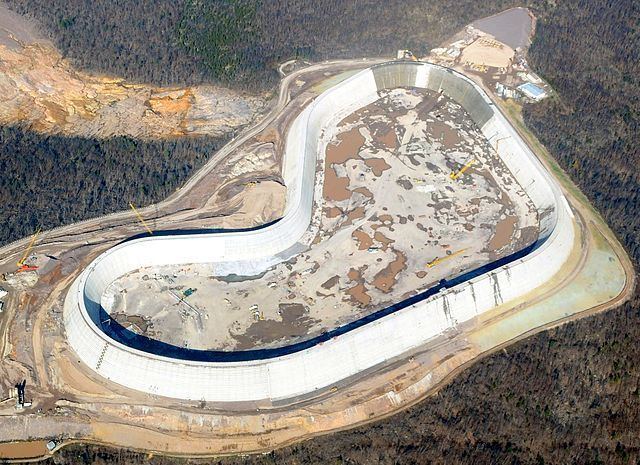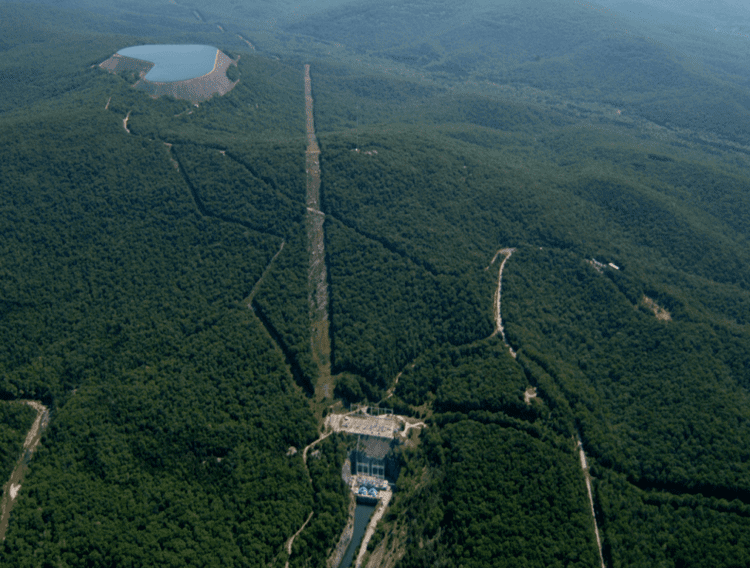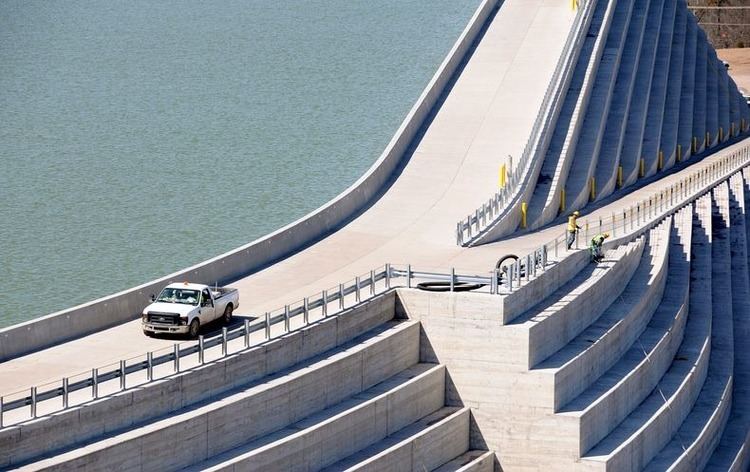Country United States Construction began 1960 | Status Operational | |
 | ||
Commission date December 20, 1963 (1963-December-20) Construction cost $50 million USD (1963), $490 million USD rebuild (2010) Similar Taum Sauk Mountain State Park, Taum Sauk Mountain, Elephant Rocks State Park, Ozark Trail, Saluda Dam | ||
Taum sauk hydroelectric power station
The Taum Sauk pumped storage plant is in the St. Francois mountain region of the Missouri Ozarks about 90 miles (140 km) south of St. Louis near Lesterville, Missouri, in Reynolds County. It is operated by the AmerenUE electric company.
Contents
- Taum sauk hydroelectric power station
- Size and locationEdit
- Leaks and liningEdit
- Upper reservoir failureEdit
- Litigation and investigationsEdit
- ReconstructionEdit
- References

The pumped-storage hydroelectric plant was built to help meet peak power demands during the day. Electrical generators are turned by water flowing from a reservoir on top of Proffit Mountain into a lower reservoir on the East Fork of the Black River. At night, excess electricity on the power grid is used to pump water back to the mountaintop.

The Taum Sauk plant is an open-loop pure pumped operation: unlike some other pumped storage sites, there is no natural primary flow into the upper reservoir available for generation. It is therefore a net consumer of electricity; the laws of thermodynamics dictate that more power is used to pump the water up the mountain than is generated when it comes down. However, the plant is still economical to operate because the upper reservoir is refilled at night, when the electrical generation system is running at low-cost baseline capacity. This ability to store huge amounts of energy led its operator to call Taum Sauk "the biggest battery that we have".

Construction on Taum Sauk began in 1960, and it went into operation in 1963 with two reversible pump-turbine units that could each generate 175 megawatts (235,000 hp) of power. It was not licensed by the Federal Power Commission (the predecessor of the Federal Energy Regulatory Commission) because Union Electric contended that the FPC did not have jurisdiction over the non-navigable headwaters where the power station was constructed. In FPC v. Union Elec. Co., 381 U.S. 90 (1965), the United States Supreme Court held that the FPC did have jurisdiction and that Taum Sauk did require a FPC license. Although designed and built without federal supervision, a license was retroactively granted.

At the time, the Taum Sauk plant was by far the largest pumped storage plant in North America in a number of measures, and was considered a major milestone in the development of pumped storage technology. In 1999, the plant was upgraded with units capable of 225 megawatts (302,000 hp) apiece.

On December 14, 2005, a catastrophic failure in the upper reservoir dam put the plant out of operation until it was rebuilt, recertified, and reopened on April 21, 2010. The new upper reservoir dam, rebuilt from the ground up, is the largest roller-compacted concrete dam in North America.
The plant was named an IEEE Milestone in October 2005, just months before the Upper Reservoir failed. It was subsequently rededicated as an IEEE Milestone in 2010 after the new upper reservoir dam was completed.
Size and locationEdit
The upper reservoir can hold about 1.5 billion U.S. gallons or 5.7 gigalitres of water (4,600 acre feet (5,700,000 m3)) behind a wall nearly 100 feet (30 m) tall. It sits 760 feet (230 m) above the 450 MW hydroelectric plant, which gives it a greater head than that of Hoover Dam. The two are connected by a 7,000-foot (2,100 m) tunnel bored through the mountain.
The Taum Sauk upper reservoir sits atop Proffit Mountain, not Taum Sauk Mountain about 5 miles (8.0 km) to the east. It is visible from Route 21 north of Centerville and from Route N approaching Johnson's Shut-ins State Park from the south.
Before the failure of the upper reservoir, visitors could drive to the top of Proffit Mountain and walk to an observation deck above the reservoir. Ameren operated a museum at the entrance gate highlighting the geologic and natural history of Missouri. The power plant was frequently visited by geology students because of a striking example of Precambrian/Cambrian unconformity in the rock layers exposed by the plant's construction.
Leaks and liningEdit
There had been minor leaks in the reservoir since it was constructed. A collection pond and pumpback station was eventually installed to collect and return leakage to the reservoir. From September 13, 2004, to November 15, 2004, Geo-Synthetics installed lining material to reduce leaks.
Upper reservoir failureEdit
At 5:12 a.m. on December 14, 2005, the northwest side of the upper reservoir was overtopped when water continued to be pumped from the lower reservoir after the upper was full. This led to the catastrophic failure of a triangular section of the reservoir wall and the release of 1 billion US gallons (3.8 Gl) of water in twelve minutes. The sudden release sent a 20-foot (6.1 m) crest of water down the East Fork of the Black River.
A combination of design and construction flaws, continuing to operate the dam when the primary system for gauging the water level was known to be inaccurate (gauge pipes had become detached), moving the "failsafe" secondary gauging system above the actual height of the dam to avoid false positives, and operating the dam in an unsafe manner by routinely overfilling the reservoir caused the upper reservoir dam to overtop. There was no overflow spillway in the original reservoir.
A memo from Richard Cooper, superintendent of Ameren's Taum Sauk Hydroelectric Plant, indicated that the reservoir had a "Niagara Falls" style overflow on September 27 at the same spot that was breached (caused by wave action related to winds from Hurricane Rita.) Another Cooper memo had also indicated that Cooper had warned that gauges used to monitor the water height in the reservoir were malfunctioning in October.
No one was killed by the failure. The superintendent of Johnson's Shut-Ins and Taum Sauk State Parks, Jerry Toops, his wife and three children were swept away when the wall of water obliterated their home. They survived, suffering from injuries and exposure. The children were transported to a hospital in St. Louis and later released. One child was treated for severe burns which resulted from heat packs applied by rescue workers as treatment for hypothermia.
The dam of the lower reservoir, which by design is able to hold much of the capacity of the upper reservoir, withstood the onslaught of the flood. By storing most of the deluge it spared towns downstream, including Lesterville and Centerville, from a damaging flood. A voluntary evacuation order was issued for those areas, but there was no damage. The high water was stopped at Clearwater Lake, the dam of which was not damaged by the rising waters.
Litigation and investigationsEdit
The Federal Energy Regulatory Commission fined Ameren $15 million pursuant to a settlement for the breach at Taum Sauk. This is the second highest fine ever levied by FERC, only outstripped by the fine and subsequent settlement against FPL regarding the 2008 Florida electricity blackout.
The State of Missouri sued Ameren for Actual and Punitive Damages alleging Ameren was reckless in its operation of the plant.
The Missouri Highway Patrol delivered a report of its criminal investigation to the Attorney General in June 2007 which "did not name any suspect" and the Attorney General made a statement that there would be no criminal charges. According to press reports, the report states that Ameren failed to provide the identity of the person who raised the gauges meant to prevent overtopping and also states that the gauges were moved before investigators were on the scene.
KMOX radio in St. Louis reports that the EPA assisted by the U.S. Attorney's Office has begun an investigation into violations of the Clean Water Act and has requested the Highway Patrol's report.
The Public Service Commission reopened its investigation (based on the Highway Patrol report) and subsequently found the accident to be a failure of Ameren management, stating:
...the Commission can only conclude that the loss of the Taum Sauk plant was due to imprudence on the part of UE (Ameren's AmerenUE Subsidiary). UE was well-aware of the catastrophic results likely to occur if the UR (Upper Reservoir) was overtopped by over-pumping. UE knew, or should have known, that storing water against the parapet wall of a rockfill dam was “unprecedented.” UE knew,or should have known, that operating with a freeboard of only one or two feet left no margin for error and required particularly accurate control of the UR water level. Given that circumstance, UE’s decision to continue operating Taum Sauk after the discovery of the failure of the gauge piping anchoring system and the consequent unreliability of the piezometers upon which the UR control system was based is frankly beyond imprudent – it is reckless. UE also knew or should have known that the upper Warrick probes had been reset above the lowest point at the top of the UR." (PSC Report page 71, definitions of Acronyms added)
Ameren had 90 days from the date of the report to answer back to the PSC how it will meet the recommendations of the report, which include a whistle blower rule, changes in safety management structure, financial accounting for the rebuild of the upper reservoir, and single point of management for the rebuild.
As of late 2011, Ameren was reported to have paid a total of close to $200 million in settlements related to the 2005 breach.
ReconstructionEdit
Federal regulators approved Ameren's plan to rebuild the reservoir, and construction began in late 2007. The rebuilt structure is made entirely of roller-compacted concrete, unlike the earth-fill original. In addition to more robust fill-detection instrumentation it incorporates a spillway rated to handle overflow equal to the maximum capacity of both pumping units and a video system to visually monitor the water level. The USD $490 million cost of rebuilding the reservoir was covered partially by insurance. The utility was prohibited from billing customers to recoup any of the cost.
Water was pumped into the rebuilt reservoir for the first time on February 27, 2010, and engineers monitored the response of the new structure as the water level was repeatedly raised and lowered. The final approval required from the FERC for “return to normal project operations” was received on April 1, 2010. The utility met the Missouri Public Service Commission’s in-service criteria for operations on April 15, and electricity was first generated from the new structure on April 21, 2010. The new dam was recognized by the U.S. Society on Dams with its "Award of Excellence in the Constructed Project". On September 27, 2010, IEEE rededicated the plant as an IEEE milestone.
